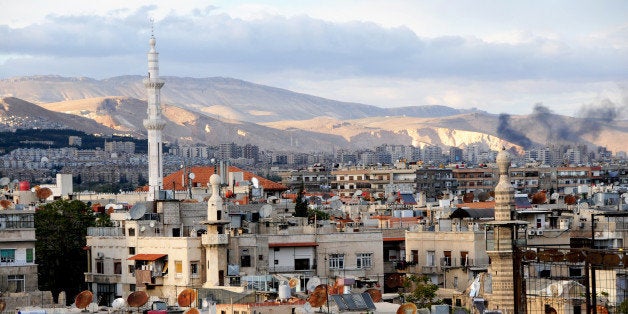
Hostage to the Assad Regime or partner to it is the overarching question posed by Cycle of Fear - Syria's Alawites in War and Peace and The Alawis of Syria - War, Faith and Politics in the Levant, two timely pieces of work that look into the history, society and modern political challenges of Syria's under-researched Alawite community.
Goldsmith, who teaches political science in Oman, has been studying the Alawites who make up 15% of the Syrian population since 2007. His early history tells the story of a minority community's insecurity in the face of sectarian conflict describing how 'every major power shift in the Alawite region since the eleventh century had been accompanied by an initial period of repression against the Alawites.
Episodes of persecution and intolerance were found under the Ayyubids, Crusaders, Mamluks and beyond. Under the Ottomans there were periodic clampdowns and a special head tax levied on Alawite 'apostates' for their 'heresy.' The mountain range of 'Jabal al-Sahiliyah' became a refuge for the various Alawite tribes despite the fact that its harsh environment meant that settlements were highly compartmentalised which hindered community cohesion.
The Alawite religion was historically closed and as difficult to access as the mountain they lived in, leading many to refer to it as secretive and draw their own conclusions to what they did and did not practice. A British traveller, Henry Maundrell, in 1697 wrote that the Alawites were 'of a strange and singular character' and 'great drinkers'. Although Goldmsith makes the point that it was sensible for a religious minority to keep their practices secret to avoid persecution.
The French mandate period (from 1922) provided a chance for the Alawites to proceed on an 'equal footing' and look to emerge from beyond the mountains. 1937 was a key year when the coastal region of Syria, home to the majority of the Alawite population, was officially joined to the rest of the country. It showed on the spectrum of integration or rejection a willingness of the population to join with a 'wider, Sunni-dominated, Syrian society'.
Under the Assad regime, which has dominated the post-independence period, 'fear and insecurity' argues Goldsmith, helped shape the Alawite identity and behavior. Yet it was also the time of being 'catapulted from obscurity into the middle of Syrian and Middle Eastern politics' and for many Alawites 'the Assad regime symbolized their rise to equality in Syrian society after centuries of marginalization and periodic persecution' . The key point that Goldsmith makes though is that 'despite the fact that Alawites underpinned the stability of the Assad regime, this still did not make it a Alawite regime'.
The Muslim Brotherhood uprising in the 1980s signified an 'intractable apathy against the perceived Alawite nature of the regime' and sectarian security strengthened and made resilient the group felling or Alawite 'asabiyya' after 'centuries of mistrust and hostility between Alawites and Sunnis.' Goldsmith describes the destruction of Hama in 1982 as a 'Faustian Bargain' that would forever hang over the Alawites fear of future revenge. Relations were different under Bashar and described as a significant shift from his father, as new economic policies led some to believe he was 'abandoning his own sect' and led to a 'crumbling of Alawite asabiyya' in advance of the outbreak of uprising followed by civil war in 2011.
Goldsmith uses frequent references to the historian Ibn Khaldun's theories in addition to a smattering of his own personal field research and photos to add color to the narrative. The biggest critique of Goldsmith's highly readable work is his rather throwaway line late in the book that 'the best chance for Alawite security in Syria was to abandon the Assad dynasty and finally seek genuine integration in Syrian society.' Such a bombshell is left largely unexplored and feels like a lightweight hypothetical in comparison to the studious research built around it.
Kerr and Larkin's edited edition is made up of fourteen authors and came out of a workshop held at Kings College London in January 2014. Farouk-Alli explains that 'prior to the division of the Middle East into nation states in the twentieth century, religious belief was the primary identity marker for the people of this realm' Alawite identiy, while 'mysterious', was complex as they had a 'operational identity' that could and would move along a spectrum of family - tribe - confessional community - nation and supra-nation (pan-Arabism/Islamism).
Goldsmith is one of the contributors to the Kerr/Larkin book and emphases again how 'insecurity lies at the centre of the contradictions in Alawi identity between diversity and integration, solidarity and conflict'. Winter's chapter provides an interesting challenge to histories of the Ottoman period writing that when it comes to a popular understanding of the 'millet' system - 'no such system ever existed'. Winter also 'puts to rest' the notion that Ottoman rule discriminated against the Alawites without clearly referencing who he was arguing against which left the reader feeling he'd been fed a straw dog of sorts.
When is comes to the Syrian uprising and subsequent civil war Raymond Hinnebusch writes an excellent chapter explaining that the 'Alawis turned from a force for change in Syria into a defender of the statist status quo'. Hinnebusch skillfully traces the pre-2011 hollowing out of the Ba'ath party and neglect of rural areas as fatal mistakes on the part of Bashar al-Assad. This is a stark contrast to what Fabrice Balance describes what happened in the 1960s with the 'seizure and redistribution of large agricultural domains' from the urban elite.
Aron Lund provides an interesting insight into the mysterious 'Shabiha' forces, explaining that they've become a catchall for 'pro-Assad' militias and obscure the far more strategic use of the 'National Defense Forces' and sub-state actors at large. Reinoud Leender completes the book with an examination of the logic of the regime's use of violence which also touches on the Goldsmith dichotomy of 'hostage or partner.' Carsten Wieland also looks into this in respect to the Alawi involvement in the Syrian opposition described as 'Janus face...both perpetrators and victims.'
As with any multiple author edition there is a degree of duplication throughout as chapters cover similar ground and the work could be a bit sleeker. However in summary the work provides a very modern insight into a rapidly changing conflict that is a must read for those wanting to go into the DNA of Syria's recent history.
